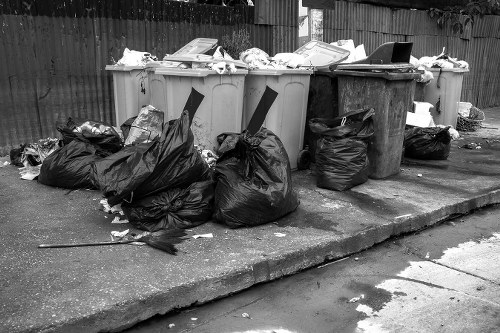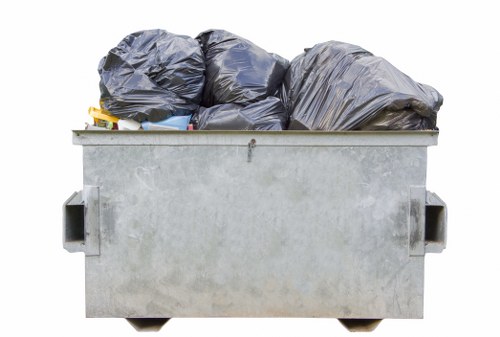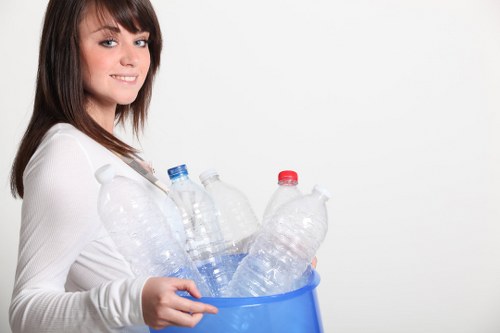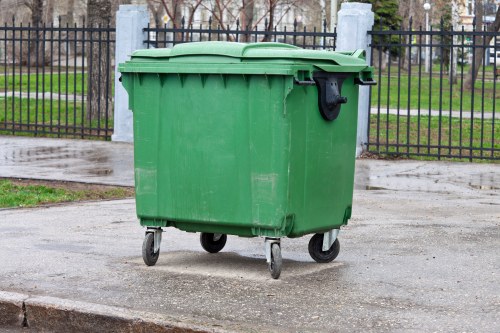White Goods Recycle in Council Waste Collection
Understanding White Goods Recycling

Recycling white goods is an essential aspect of managing household waste responsibly. White goods, which include appliances like refrigerators, washing machines, and dishwashers, play a significant role in our daily lives. However, disposing of them improperly can have severe environmental impacts.
Local councils offer waste collection services specifically designed to handle the recycling of these bulky items. By utilizing council waste collection, residents can ensure that their old appliances are disposed of in an environmentally friendly manner.
Recycling white goods not only helps reduce landfill waste but also conserves valuable resources by recovering materials that can be reused in manufacturing new products.
Benefits of Recycling White Goods

There are numerous advantages to recycling white goods through council waste collection services:
- Environmental Protection: Proper recycling minimizes the release of harmful substances into the environment.
- Resource Conservation: Recovering metals and plastics reduces the need for virgin materials.
- Energy Savings: Recycling processes typically consume less energy compared to manufacturing from raw materials.
- Economic Benefits: Recycling can create jobs and support local economies.
Moreover, many councils offer incentives or rebates for residents who participate in recycling programs, making it a cost-effective solution as well.
Engaging in white goods recycling fosters a culture of sustainability within communities, encouraging others to adopt eco-friendly practices.
How Council Waste Collection Works

Understanding the process of council waste collection can help residents make informed decisions about recycling their white goods.
Scheduling a Pickup: Most local councils provide scheduled pickups for bulky waste, including white goods. Residents can arrange a convenient time for their appliances to be collected.
- Check your council's website for specific collection dates and guidelines.
- Book your collection online or via a dedicated phone line.
- Ensure that the items are ready and accessible on the specified day.
Once collected, the white goods are transported to designated recycling facilities where they undergo sorting and processing.
At these facilities, technicians dismantle the appliances, separating materials like metals, plastics, and electronics for recycling.
Preparing Your White Goods for Recycling

Proper preparation of white goods is crucial to ensure a smooth recycling process.
Steps to Prepare:
- Disconnect Appliances: Ensure all appliances are unplugged and disconnected from power sources.
- Clean the Items: Remove any food residues or personal items from appliances like refrigerators and washing machines.
- Secure Doors and Components: Fold in doors and secure any moving parts to prevent damage during transport.
- Remove Hazardous Materials: Safely dispose of batteries or refrigerants according to council guidelines.
Following these steps not only facilitates efficient recycling but also complies with safety and environmental regulations.
Additionally, labeling appliances with relevant information can aid recycling facilities in processing items more effectively.
Council Regulations and Guidelines

Each council may have specific regulations and guidelines regarding the recycling of white goods. It is important to familiarize yourself with these rules to ensure compliance and efficient service.
- Accepted Items: Confirm which types of white goods are eligible for recycling.
- Disposal Fees: Some councils may charge a fee for the collection and recycling of certain appliances.
- Registration Requirements: Registering your appliances before collection might be necessary in some areas.
- Environmental Standards: Adhere to the council’s environmental standards to ensure proper handling of hazardous materials.
Adhering to these regulations helps maintain the efficiency of the recycling program and supports the overall sustainability goals of the community.
For detailed information, visiting your local council’s official website or contacting their waste management department is recommended.
Challenges in White Goods Recycling
While recycling white goods has many benefits, there are also challenges that need to be addressed to improve the effectiveness of these programs.
Complexity of Appliances: Modern white goods contain various materials and components, making the recycling process more intricate and time-consuming.
- Mixed Materials: Separating different materials without causing damage is a significant challenge.
- Hazardous Components: Items like refrigerants require careful handling to prevent environmental harm.
- Technological Advancements: Rapid advancements in appliance technology can outpace recycling methods.
Addressing these challenges requires continuous innovation in recycling technologies and increased collaboration between manufacturers, councils, and recycling facilities.
Public education and awareness campaigns can also play a vital role in mitigating these obstacles by encouraging proper disposal practices.
Innovative Solutions for Effective Recycling
To overcome the challenges associated with white goods recycling, various innovative solutions are being implemented.
Advanced Sorting Technologies: Utilizing automated systems and AI to accurately sort materials can enhance efficiency and reduce labor costs.
- Robotic Sorting: Robots equipped with sensors can identify and separate different materials effectively.
- AI Algorithms: Machine learning can optimize the sorting process by predicting material types based on appliance models.
- Efficient Processing: Streamlining the recycling workflow minimizes delays and increases throughput.
These technological advancements not only improve the accuracy of material recovery but also contribute to the sustainability of recycling operations.
Extended Producer Responsibility (EPR): Implementing EPR policies holds manufacturers accountable for the end-of-life management of their products, encouraging the design of more recyclable appliances.
EPR fosters a circular economy by ensuring that resources are continuously reused, reducing the environmental footprint of white goods.
Community Involvement and Education
Community participation is crucial for the success of white goods recycling programs.
Awareness Campaigns: Educating residents about the importance of recycling and the proper methods to dispose of white goods can significantly increase participation rates.
- Workshops and Seminars: Hosting events to inform the public about recycling practices.
- Informational Materials: Distributing brochures and online content to provide guidelines and benefits of recycling.
- School Programs: Integrating recycling education into school curricula to instill sustainable habits from a young age.
Engaging the community through these initiatives fosters a collective responsibility towards environmental stewardship.
Furthermore, providing easy access to recycling services and clear instructions can remove barriers that prevent residents from participating.
The Future of White Goods Recycling
The landscape of white goods recycling is continually evolving, driven by technological advancements and increasing environmental awareness.
Sustainable Design: Manufacturers are increasingly focusing on designing appliances that are easier to recycle, using fewer hazardous materials and incorporating modular components.
- Eco-friendly Materials: Utilizing sustainable materials that can be easily separated and recycled.
- Modular Construction: Designing appliances with removable parts to simplify the recycling process.
- Energy-efficient Technologies: Reducing the overall energy consumption of appliances aligns with sustainability goals.
Such design innovations not only facilitate easier recycling but also enhance the overall sustainability of consumer products.
Policy Developments: Governments and councils are likely to introduce more stringent regulations and incentives to promote white goods recycling.
These policies can drive greater participation and investment in recycling infrastructure, ensuring long-term environmental benefits.
Choosing the Right Council Service
Selecting the appropriate council waste collection service is essential for effective white goods recycling.
Service Availability: Confirm that your council offers white goods recycling and understand the specific services provided.
- Collection Frequency: Know how often collections occur and plan accordingly.
- Accessible Scheduling: Ensure that the scheduling process is user-friendly and accommodates your availability.
- Additional Services: Some councils may offer pickup assistance or provide guidelines for preparing items for recycling.
Evaluating these factors can help you choose a service that best meets your recycling needs.
Additionally, reading reviews and seeking recommendations can provide insights into the reliability and efficiency of the service.
Cost-Effectiveness of Recycling White Goods
Recycling white goods through council waste collection can be a cost-effective alternative to traditional disposal methods.
Reduced Disposal Fees: Some councils offer free or subsidized collection services for bulky waste, making recycling more affordable.
- Comparing Costs: Assess the costs associated with different disposal options to determine the most economical choice.
- Incentive Programs: Take advantage of any available incentives or rebates offered by your council.
- Long-term Savings: Proper recycling can lead to long-term savings by promoting the reuse of materials.
By opting for council waste collection, residents can manage their household waste efficiently without incurring significant expenses.
Furthermore, the environmental benefits of recycling contribute to societal savings by reducing pollution and conserving resources.
Environmental Impact of White Goods Recycling
The environmental impact of recycling white goods is substantial, contributing to various aspects of sustainability.
Waste Reduction: Recycling minimizes the volume of waste sent to landfills, extending their lifespan and reducing associated environmental issues.
- Landfill Space Conservation: Less waste means more preserved land for other ecological purposes.
- Pollution Control: Proper recycling reduces the risk of soil and water contamination from hazardous waste.
- Carbon Footprint Reduction: Recycling processes generally emit fewer greenhouse gases compared to manufacturing from raw materials.
Additionally, recycling supports the conservation of natural resources, ensuring their availability for future generations.
By participating in white goods recycling, individuals contribute to the broader effort of combating climate change and promoting environmental health.
Case Studies: Successful Recycling Programs
Examining successful white goods recycling programs can provide valuable insights into best practices and effective strategies.
Municipality A: Implemented a comprehensive recycling program with generous incentives, resulting in a high participation rate among residents.
- Incentive Structures: Offered rebates for recycled appliances, encouraging more people to participate.
- Public Awareness: Conducted extensive marketing campaigns to educate the community about the benefits of recycling.
- Efficient Logistics: Streamlined the collection process to ensure timely and hassle-free pickups.
These measures led to a significant reduction in household waste and increased resource recovery.
Municipality B: Focused on technological innovations to enhance the recycling process.
By investing in advanced sorting technologies and training personnel, Municipality B achieved higher material recovery rates and improved operational efficiency.
Tips for Maximizing Recycling Efficiency
To make the most of white goods recycling, consider the following tips:
- Plan Ahead: Schedule pickups in advance to ensure your appliances are recycled promptly.
- Follow Guidelines: Adhere to your council’s preparation and disposal guidelines to facilitate efficient processing.
- Stay Informed: Keep up with any updates or changes in recycling policies and practices.
- Advocate for Recycling: Encourage neighbors and community members to participate in recycling programs.
Implementing these practices can enhance the effectiveness of recycling efforts and contribute to a more sustainable environment.
Additionally, staying engaged with local recycling initiatives can help you stay informed about new opportunities and improvements in waste management.
Conclusion: Embracing Sustainable Waste Management
Recycling white goods through council waste collection is a pivotal component of sustainable waste management. By responsibly disposing of appliances, residents can significantly reduce their environmental impact, conserve resources, and support the circular economy.
Take Action Today: Don’t wait to contribute to a greener future. Contact us today to learn more about your local council’s white goods recycling program and schedule your appliance pickup.
Embracing recycling not only benefits the environment but also fosters a sense of community responsibility and stewardship. Let’s work together to create a sustainable world for future generations.
Additional Resources
For more information on white goods recycling and council waste collection services, consider exploring the following resources:
- Local Council Website: Access detailed guidelines and service schedules.
- Environmental Agencies: Learn about broader recycling initiatives and environmental policies.
- Community Workshops: Participate in events focused on sustainable living and waste management.
- Recycling Facilities: Understand the processes and technologies involved in recycling white goods.
Staying informed and engaged with these resources can empower you to make environmentally conscious decisions and effectively participate in recycling programs.
Book your service now and take a significant step towards responsible waste management and environmental sustainability.